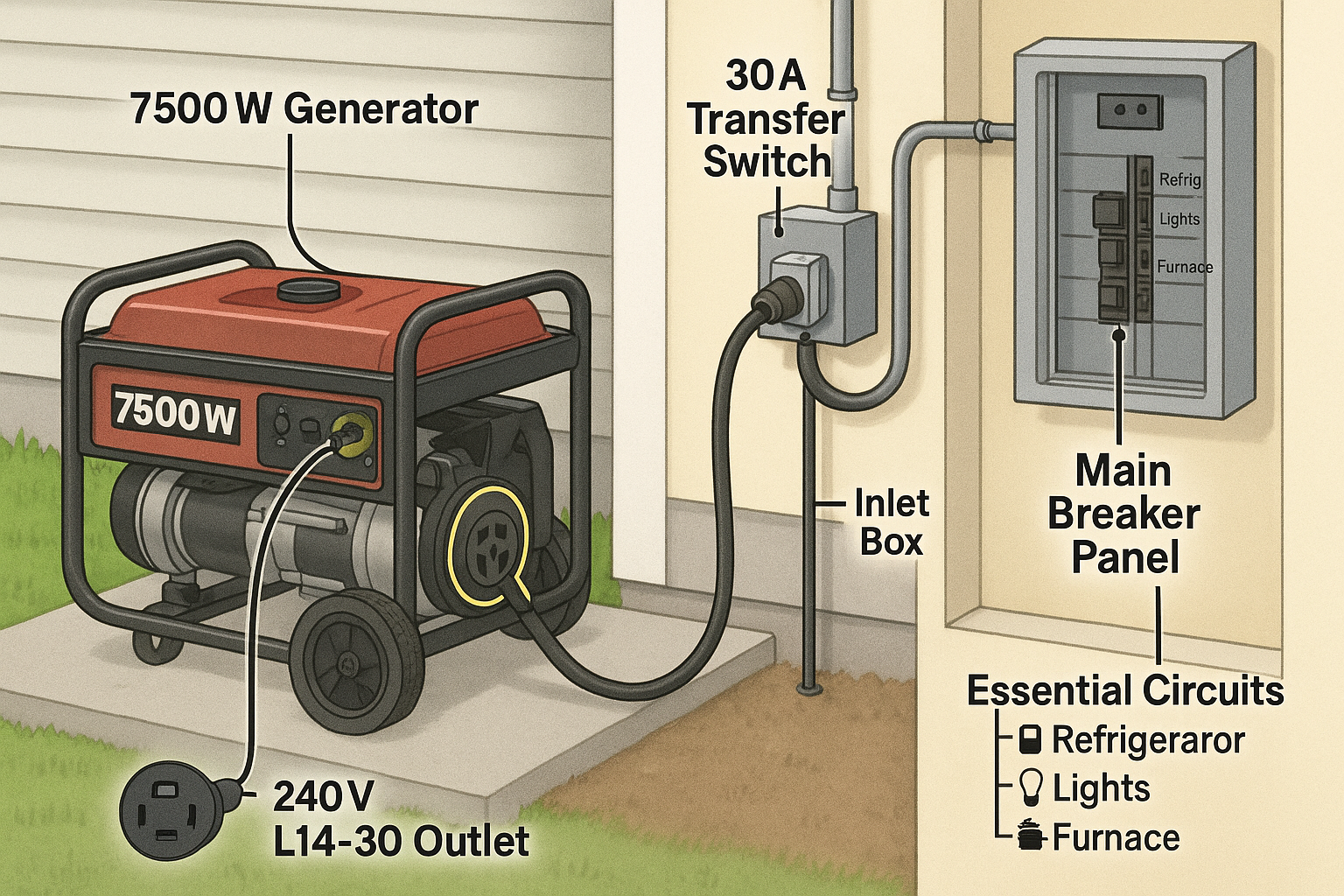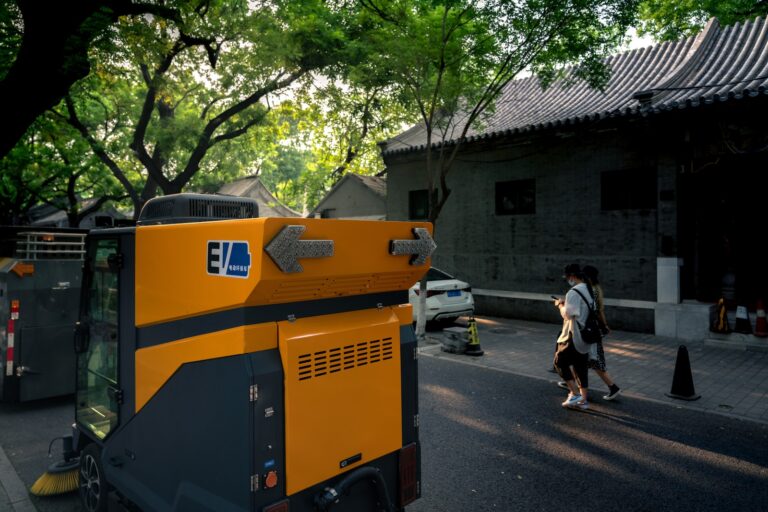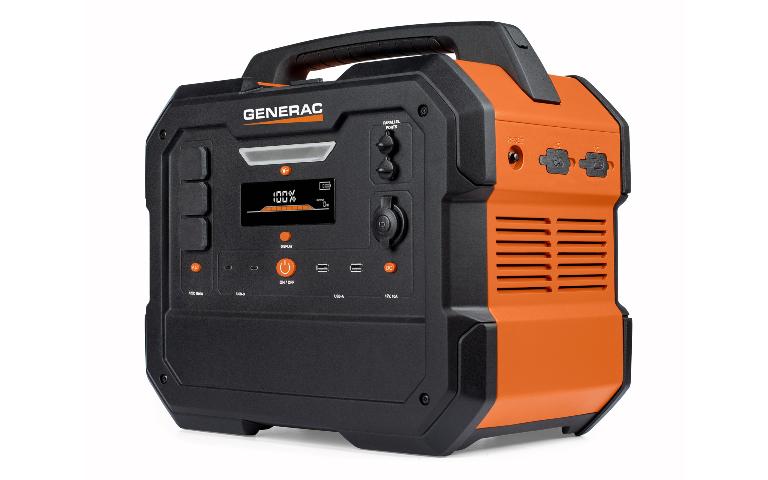What Size Transfer Switch Do I Need for a 7500W Generator? The Complete Guide
A transfer switch is a safety device that physically disconnects your home from the utility grid while connecting it to your generator. Without one, “backfeeding” can electrify utility lines, killing linemen and violating electrical codes. For a 7500W generator (common for home backup), selecting the right size transfer switch ensures safe, efficient power delivery during outages. This guide demystifies sizing, installation, and load management—helping you protect both your family and equipment.
II. Understanding Your 7500W Generator’s Output
Key Electrical Specifications:
- Running Watts: Continuous power output (typically 6,000–6,800W for “7500W” generators).
- Starting Watts: Peak capacity for motor surges (7,500W–9,500W).
- Amperage Calculation:
- At 120V: 6,000W ÷ 120V = 50A
- At 240V: 6,000W ÷ 240V = 25A (most 7500W generators use 240V via L14-30 outlets).
⚠️ Critical Insight: Generators like the Generac GP7500E or DuroMax XP7500EH label “7500W” as peak output. Always size your transfer switch for running watts (e.g., 6,000W).
III. Transfer Switch Fundamentals
Types & Functions:
- Manual Transfer Switch (MTS):
- Requires flipping switches during outages.
- Ideal for portable generators.
- Cost: $200–$500.
- Automatic Transfer Switch (ATS):
- Self-activates when grid power fails.
- Used with standby generators.
- Cost: $500–$1,500.
Installation Point: Mounts beside your main electrical panel. Physically prevents utility and generator power from energizing simultaneously.
IV. Transfer Switch Sizing Principles
Transfer switches are rated in amps—not watts. Key rules:
- Match Generator Output: 7500W (6,000W running) @ 240V = 25A → Requires 30A switch (industry standard).
- NEC Safety Margin: Switches must be rated for 125% of continuous load: 25A × 1.25 = 31.25A → Round up to a 30A or 40A switch.
- Voltage Compatibility: 240V systems need double-pole switches (breaks both hot wires).
V. Recommended Size: 30-Amp Transfer Switch
Why 30A?
- 7500W generators use L14-30 outlets (30A, 240V compatible).
- Matches running amperage (25A) with a safety buffer.
- Examples:
- Reliance Controls 31406CRK (30A, 6-circuit)
- Generac Rxsw200A3 (30A manual switch)
✨ Pro Tip: A 30A switch costs 40% less than a 50A model and fits your generator’s plug without adapters.
VI. Manual vs. Automatic: Which for 7500W?
| Factor | Manual Transfer Switch | Automatic Transfer Switch |
|---|---|---|
| Cost | $200–$500 | $500–$1,500+ |
| Activation | Manual (flip switches) | Automatic (senses outage) |
| Installation | Easier, DIY-friendly | Requires professional setup |
| Best For | Portable generators | Standby generators |
Verdict: Manual switches are ideal for 7500W portables. ATS is overkill unless upgrading to a standby unit.
VII. Circuit Management: Critical Loads vs. Whole House
A 7500W generator CANNOT power a whole house. Average homes need 20,000–30,000W. Prioritize 6–10 circuits:
- Essential Loads: Refrigerator (700W), furnace fan (800W), well pump (1,000W), lights (100W/circuit), Wi-Fi (50W).
- Transfer Switch Types:
- Single-Circuit: Powers 1–2 appliances via dedicated outlets.
- Multi-Circuit: 6–10 pre-selected circuits (recommended).
Load Calculation Example:
| Appliance | Running Watts | Surge Watts |
|---|---|---|
| Refrigerator | 700W | 2,200W |
| Furnace Fan | 800W | 1,300W |
| 10 LED Lights | 100W | 100W |
| Total | 1,600W | 3,600W |
VIII. Key Selection Criteria
- Plug Compatibility: Ensure switch matches your generator’s L14-30 receptacle.
- UL Listing: Must be UL 1008 certified for safety.
- Generator Inlet Box: Required for outdoor connections (e.g., Reliance PB30).
- Wire Gauge: Use 10-gauge copper wire for 30A/240V setups (max 50 ft length).
- Professional Installation:
- 90% of jurisdictions require licensed electricians.
- Costs $300–$800 (switch not included).
IX. Installation & Safety Protocol
- Shut Off Main Breaker: Before any work.
- Mount Inlet Box: Outdoor location near generator.
- Connect Wires:
- Inlet box → Transfer switch (10-gauge wire).
- Transfer switch → Circuit breakers.
- Grounding: Connect generator frame and switch to grounding rod.
- Test System: With main breaker OFF, start generator and verify circuits.
⚠️ Never Use “Suicide Cords”: Plugging generators into dryer outlets bypasses transfer switches and is illegal.
X. FAQs
Q1: Can I use a 50A transfer switch with a 30A generator?
Yes, but you’ll need an adapter and risk overloading the generator. Stick with 30A.
Q2: What if my generator only has 120V outlets?
Use a 30A single-pole switch (e.g., L5-30 plug), but 240V is more efficient.
Q3: Do I need a permit?
Yes—in most areas, permits and inspections are mandatory.
Q4: Can I power central AC with a 7500W generator?
No—central AC requires 3,500W–7,000W per ton, exceeding your capacity.
XI. Conclusion: Safety Meets Practicality
For a 7500W generator, a 30-amp double-pole manual transfer switch is the gold standard. It matches your generator’s L14-30 outlet, powers 6–10 critical circuits, and complies with NEC safety margins. Remember:
- Prioritize essential loads—never attempt whole-house backup.
- Hire a licensed electrician for installation and permits.
- Always ground the system and use an inlet box.
By pairing your generator with a correctly sized transfer switch, you ensure reliable, legal, and life-saving power during outages.
Final Tip: For future upgrades, size your transfer switch to your next generator (e.g., a 50A switch for a 12,000W unit).



